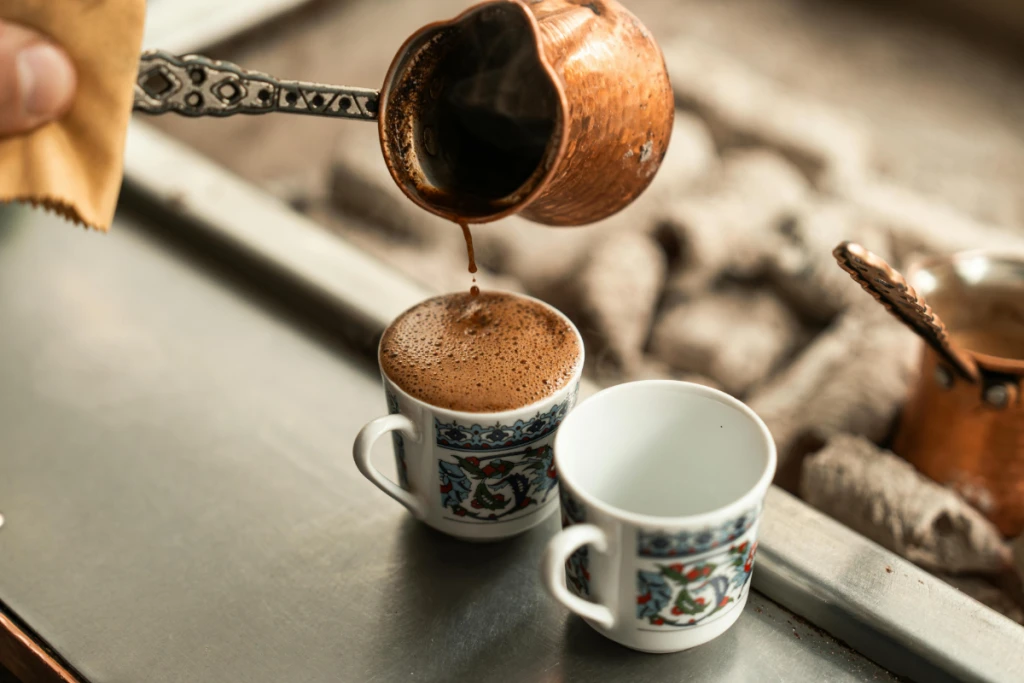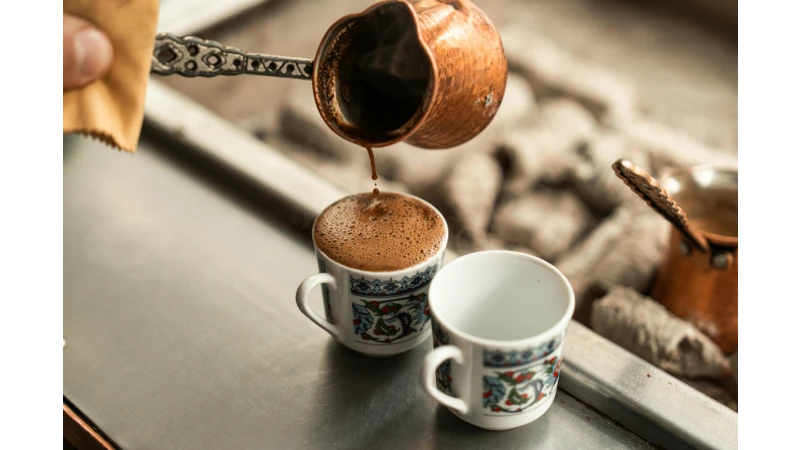Turkish Coffee Tasting – Tradition, History & Culture

Turkish Coffee Tasting Experience – A Cultural Journey in Turkey
Introduction
One of the most authentic cultural experiences you can have in Turkey is a traditional Turkish coffee tasting. More than just a drink, Turkish coffee (Türk Kahvesi) is a UNESCO-recognized cultural heritage, representing centuries of tradition, hospitality, and artistry.
Served in small porcelain cups with a rich foam on top, Turkish coffee is enjoyed slowly, often accompanied by Turkish delight or chocolate. Beyond taste, it is about ritual, conversation, and even fortune-telling through coffee grounds.
📍 Related Read: Grand Bazaar Istanbul – History & Shopping Guide
History of Turkish Coffee
Origins of Coffee in the Ottoman Empire
- Coffee first arrived in Istanbul in the 16th century from Yemen.
- The Ottomans perfected a unique method of preparation: finely ground beans, brewed slowly in a copper cezve (long-handled pot) over hot sand or low heat.
Social and Cultural Role
- By the 17th century, coffeehouses (kahvehane) became central to Ottoman life, where poets, merchants, and politicians gathered.
- Turkish coffee became a symbol of hospitality, always offered to guests in homes.
UNESCO Recognition
In 2013, Turkish Coffee Culture and Tradition was inscribed in the UNESCO Intangible Cultural Heritage List.
🔗 External Source: UNESCO – Turkish Coffee Culture
The Art of Preparing Turkish Coffee
Ingredients
- Finely ground Arabica beans (powder-like texture)
- Cold water
- Sugar (optional – sütsüz, sade, az şekerli, orta, şekerli)
Brewing in a Cezve
- Add water, coffee, and sugar to a copper cezve.
- Heat slowly over hot sand or a small flame.
- Allow the foam to rise without boiling over.
- Pour into small cups, keeping the foam intact.
Serving Ritual
- Always served with a glass of water to cleanse the palate.
- Often accompanied by Turkish delight or chocolate.
- In the past, offering coffee to guests symbolized respect and friendship.
📍 Related Read: Turkish Night Show – Dinner & Cultural Experience
Coffee Tasting Experience in Turkey
Istanbul Coffee Houses
- Traditional venues in Sultanahmet and Beyoğlu where visitors can taste authentic Turkish coffee.
- Some offer coffee cooked in hot sand, a spectacular method that enhances flavor.
Cappadocia Coffee Experience
- Many tours in Cappadocia include Turkish coffee tasting with local sweets.
- Coffee can be enjoyed with breathtaking views of fairy chimneys and hot air balloons.
📍 Related Read: Cappadocia Travel Guide – Explore Turkey’s Fairytale Land
Coffee Fortune Telling (Fal)
- After drinking, the cup is turned upside down.
- Patterns in the coffee grounds are read for insights into the future.
- A playful tradition still popular today.
Types of Turkish Coffee
- Sade (Plain): No sugar
- Az Şekerli (Little Sugar): Mildly sweet
- Orta (Medium): Balanced sweetness
- Şekerli (Sweet): Noticeably sweet
Why Try a Turkish Coffee Tasting?
- Cultural Immersion: Learn about an Ottoman tradition still alive today.
- Unique Preparation: Experience brewing in cezve and hot sand.
- Social Ritual: Share conversation, sweets, and fortune-telling.
- UNESCO Heritage: Be part of a living tradition recognized worldwide.
📍 Related Experience: Pamukkale Travel Guide – Cotton Castle & Hierapolis
Tips for Visitors
- Drink slowly – Turkish coffee is meant to be savored.
- Don’t stir once served – this disturbs the grounds.
- Leave the grounds – they are not meant to be consumed.
- Pair with lokum (Turkish delight) for an authentic taste.
- Try fortune-telling for a fun cultural experience.
SEO Optimized FAQ – Turkish Coffee
1. What is Turkish coffee?
A traditional method of preparing finely ground coffee in a cezve, served in small cups with foam.
2. How is Turkish coffee different from espresso?
It is brewed unfiltered, thicker, and stronger in taste, with coffee grounds settling at the bottom.
3. How is Turkish coffee served?
With foam on top, alongside a glass of water and often Turkish delight.
4. Is sugar added to Turkish coffee?
Yes, but it must be added before brewing, not after.
5. What is coffee fortune-telling?
A tradition of reading coffee grounds left in the cup to predict the future.
6. Is Turkish coffee UNESCO heritage?
Yes, it was recognized by UNESCO in 2013 as an Intangible Cultural Heritage.
7. Where can I taste Turkish coffee in Istanbul?
In Sultanahmet, Grand Bazaar area, and historic coffee houses.
8. Can I buy Turkish coffee to take home?
Yes, many shops sell packaged coffee and cezves.
9. What type of beans are used?
Usually medium-roasted Arabica beans, ground into a fine powder.
10. Is Turkish coffee strong?
Yes, it is thicker and stronger compared to most brewing methods.
Conclusion
A Turkish Coffee Tasting is not just about the drink—it’s about heritage, tradition, and connection. Recognized by UNESCO, Turkish coffee represents hospitality and culture in Turkey.
Whether you try it in a historic Istanbul coffee house, during a Cappadocia tour, or with locals in their home, it is one of the most authentic experiences you can have.
Pair it with Grand Bazaar shopping, Bosphorus cruises, or Cappadocia hot air balloons for a complete Turkish adventure.
📍 Related Experience: Cappadocia Red Tour – Fairy Chimneys & Valleys













